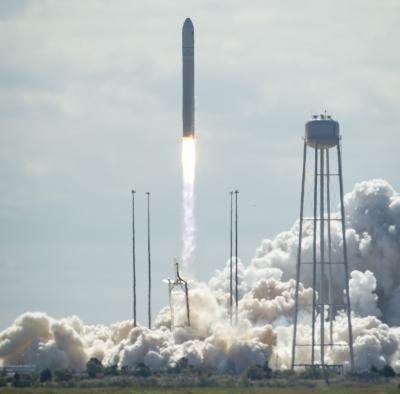Thu, Sep 19, 2013
Cygnus Cargo Spacecraft On Its Way To ISS
NASA commercial space partner Orbital Sciences Corporation of Dulles, VA, successfully launched its Cygnus cargo spacecraft aboard its Antares rocket at 1058 EDT Wednesday from the Mid-Atlantic Regional Spaceport Pad-0A at NASA’s Wallops Flight Facility in Virginia. This is the first time a spacecraft launched from Virginia is blazing a trail toward the International Space Station, heralding a new U.S. capability to resupply the orbiting laboratory.

Traveling 17,500 mph in Earth's orbit, Cygnus is on its way to rendezvous with the space station Sunday, Sept. 22. The spacecraft will deliver about 1,300 pounds of cargo, including food and clothing, to the Expedition 37 crew, who will grapple and attach the capsule using the station's robotic arm.
"Today marks a milestone in our new era of exploration as we expand the capability for making cargo launches to the International Space Station from American shores," said NASA Administrator Charles Bolden. "Orbital's extraordinary efforts are helping us fulfill the promise of American innovation to maintain our nation's leadership in space."
Orbital is building and testing its Antares rocket and Cygnus spacecraft under NASA’s Commercial Orbital Transportation Services (COTS) Program. The successful completion of the COTS demonstration mission will pave the way for Orbital to conduct eight planned cargo resupply flights to the space station through NASA’s $1.9 billion Commercial Resupply Services contract with the company. Future Cygnus flights will significantly increase NASA's ability to deliver new science investigations to the only laboratory in microgravity. As one of two U.S. carriers capable of providing cargo resupply missions to the space station, a successful demonstration mission will ensure a robust national capability to deliver critical science payloads to orbit. NASA's other cargo resupply provider, Space Exploration Technologies (SpaceX), began flying regular cargo missions to the space station in 2012, following its own COTS demonstration mission.
"Today’s launch is the culmination of more than five years’ work between the NASA and Orbital teams," said Alan Lindenmoyer, NASA’s program manager for commercial crew and cargo. "Everyone involved should be extremely proud, and we are looking forward to a successful series of checkouts between now and when Cygnus reaches the space station this weekend."
Over the next several days, Cygnus will perform a series of maneuvers to test and prove its systems, ensuring it can safely enter the so-called "keep-out sphere" of the space station, a 656-foot radius surrounding the complex.
(Image provided by NASA)
More News
Also: New SAF, Korean Air Buys 103 Boeings, Maryland SP Helo Rescue, OK AWOS Update Gulfstream Aerospace Corporation announced its first customer delivery of the all-new Gulfstream>[...]
"This is just an absolute win win win. If there is a rejected takeoff we now have the confidence that the arrestor system will ensure passenger and crew safety." Source: FAA Admini>[...]
Low Approach An approach over an airport or runway following an instrument approach or a VFR approach including the go-around maneuver where the pilot intentionally does not make c>[...]
Aero Linx: Historic Aircraft Association (HAA) The Historic Aircraft Association (HAA) was founded in 1979 with the aim of furthering the safe flying of historic aircraft in the UK>[...]
While Flying About 1,500 Ft Above Ground Level, A Large Bird Struck The Right Side Of The Airplane Analysis: The pilot reported that while flying about 1,500 ft above ground level,>[...]
 Airborne 08.29.25: G800 Delivery, Alaska F-35 Crash, USCG-RCAF Medevac
Airborne 08.29.25: G800 Delivery, Alaska F-35 Crash, USCG-RCAF Medevac Aero-News: Quote of the Day (08.30.25)
Aero-News: Quote of the Day (08.30.25) ANN's Daily Aero-Term (08.30.25): Low Approach
ANN's Daily Aero-Term (08.30.25): Low Approach ANN's Daily Aero-Linx (08.30.25)
ANN's Daily Aero-Linx (08.30.25) NTSB Final Report: Excalibur Excalibur
NTSB Final Report: Excalibur Excalibur



